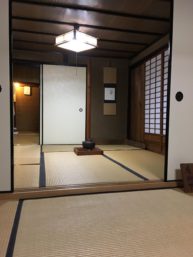From the fall of 2018 through the spring of 2019 my CIP was attending tea ceremony lessons. In the fall, I experienced how tightly knit a tea ceremony school could be, because it took a couple of lessons before the teacher and other students stopped keeping me at such a distance and treating me as a complete outsider. They kept me at a distance not to be mean nor discourage me, but because we had not yet developed a feeling of closeness and had no shared experiences. Since then my linguistic, cultural, and mechanical knowledge of the tea ceremony has increased week by week, and the distance between myself and other students has decreased in proportion. Along the way, I learned that my school takes the tea ceremony very seriously. Therefore, until they get to know a new student more and witness that student’s hard work at lessons and passion for the tea ceremony, the new student cannot become a member of the group.
With the above in mind, I also came to realize that just as Japanese culture emphasizes the group, as opposed to the individual, so too does the tea ceremony. At our tea school all students are at different levels and are of vastly different ages, but everyone learns and works together. For instance, there are only two tearooms and one tea teacher despite there often being 12-18 students learning at one time. Thus, we must work together so that lessons run smoothly, such as by helping one another in small ways to set up for practicing the tea ceremony. Likewise, we clean up together by helping those who finished practicing the tea ceremony to clean up the tools, sweets dish, etc. Then, we also learn together. Since there are so many of us in the same tearooms at the same time, our teacher could not possibly teach us one by one. Therefore, only a few students practice the tea ceremony while the rest play the part of guests. We take turns playing each part so that everyone gets to eat a sweet twice and to prepare tea once or twice.
At the head this hustle and bustle, our teacher orchestrates and oversees what the makers of tea and guests of tea do. Meanwhile, the students playing guests are expected to help one another and, when the teacher is in the other tearoom, to help give reminders, hints, etc. to those making tea. When our teacher has an important point to make about a tea ceremony type (as there are quite a few kinds), techniques, tea tools, tea ceremony décor, all students are expected to pay close attention at the same time. Whether or not this style of teaching is unique to my school, I know not. However, it makes our school at least a place to learn, make mistakes, and sometimes even laugh together—it also makes the fairly intense strictness tolerable and even enjoyable at times. And so, I am still very glad I chose this school and did not give up.
In summary, I learned that our tea school is tight knit community that takes the way of tea very seriously. However, once a student proves that their intentions for learning are serious through sincerity, hard work, and practice; our school becomes a welcoming community. In our vast world of tea inside our little tea school we learn together, work together, and admire the many tea ceremony seasons together all while making tea.

